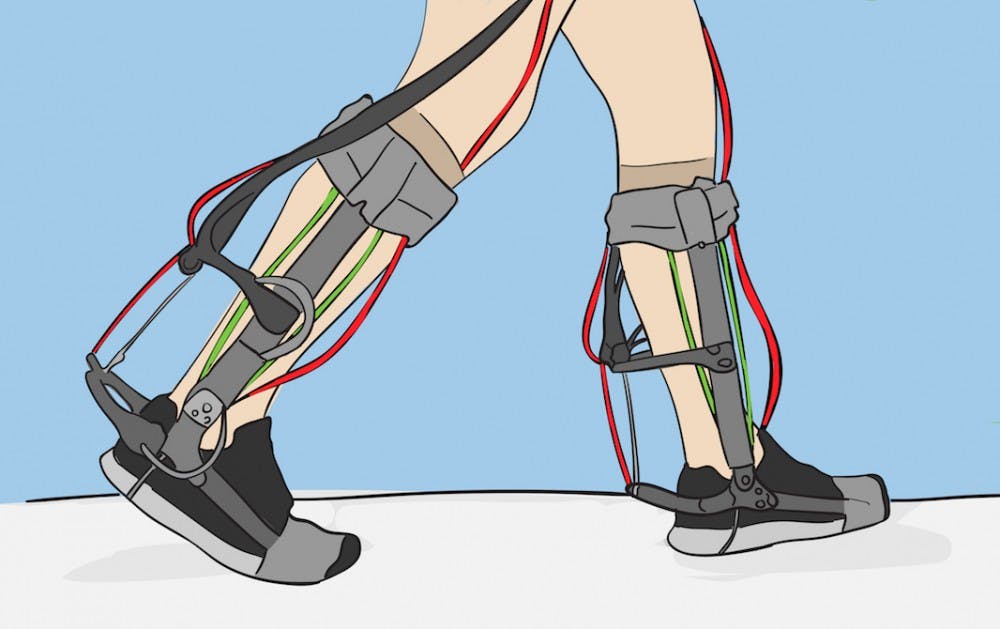ASU researchers are undertaking the task of developing wearable robotic devices in hopes of assisting humans recreationally, professionally and medically.
Wearable robotics are devices that are created specifically to augment the wearers motion and psychical capabilities, and they can also be used to restore a person's loss of motion.
Thomas Sugar, professor in the department of engineering at ASU's Polytechnic campus, said his research in wearable robotics started out developing gait trainers and an ankle device for stroke recovery therapy. In recent years, his team has begun making robotic exoskeletons for military and industry use.
"We started developing exoskeletons for the military, more specifically for ankle and hip movement to help with lifting heavy objects or overall movement," Sugar said. "Lately, we started to move more towards designing exoskeletons for industry, for helping people preform tasks in logistics such as construction or automobile companies."
Militaries have begun adopting the use of exoskeletons within the past decade with the hope of enhancing their solider's physical capabilities, and companies like Ford outfit their workers with exoskeletons to reduce stress on the workers' shoulders produced from repetitive motions.
Sugar said there are a number of different factors that go into developing an exoskeleton, such as making sure the device fits the user perfectly and that it is calibrated to their motions completely to avoid injury.
Although most of his work has been strictly professional, Sugar said his most popular device was the "jetpack" he and his team developed, with the overall goal to help people run faster.
"I was originally asked to make this by DARPA as a way of assisting people to run faster after developing robotic enhanced prosthetics for amputees, Sugar said. "It runs on an electronic motor which powers two turbines, fastened around the wearers waist that gives them a boost in their momentum."
There are some professors who argue that the future of wearable robotics is meant to be more medical than commercial. Panos Polygerinos, professor at ASU's Ira A. Fulton Schools of Engineering, said that he believes that exoskeletons are better used for assisting people to regain their motor functions.
Polygerinos specializes in soft robotics, a sub-set of wearable robotics. Specifically smaller, inexpensive actuators that assist stroke victims. The actuators give them the capability to walk and are comprised of TPU film, nylon and air pressure.
Read More: ASU Polytechnic researchers want to help stroke victims walk again
"Exoskeletons are needed if we have somebody that is entirely paralyzed, where we control all the joints needed to help make that person stand," Polygerinos said. "All their weight will have to be distributed throughout a full body exoskeleton, and then we can transfer all that weight and force into the ground to achieve movement."
Despite this divide between bulky exoskeletons and its soft-robotics counterpart, Polygerinos said that he would one day like to see a full body exoskeleton built that utilizes the actuators he is currently developing.
Although the industry of wearable robotics is still in its infancy, Saivimal Sridar, a graduate system engineering student currently working with professors Polygerinos and Sugar, said his vision for the future of wearable robotics is for it to become common-place in people's lives.
"Ideally, we would want people using them in their day-to-day lives to supplement or even enhance their current abilities," Sridar said. "For example, someone working in industry who lifts heavy objects, trying to make their lives easier, or someone who starts to lose joint function due to their health or age and giving them the ability to still retain full flexibility."
Polygerinos and Sridar both attributed their motivation to the reactions they receive from test patients, who often praise them and ask when this technology will be available on the market.
In regards to future wearable robotics being developed at ASU, Sugar said that he is currently developing a new type of robotic prosthetic ankle with the help of Panos Artemiadis, associate professor in the Mechanical and Aerospace Engineering, that will help in his overall development in motion control for exoskeletons.
"ASU has been very supportive of all the research that I've done here," Sugar said. "They've provided me with all the lab space and resources I've asked for, and I do believe that wearable robotics will have a place in all our lives in the future."
Reach the reporter at amville8@asu.edu or follow @AustinMVillegas on Twitter.
Like State Press on Facebook and follow @statepress on Twitter.




